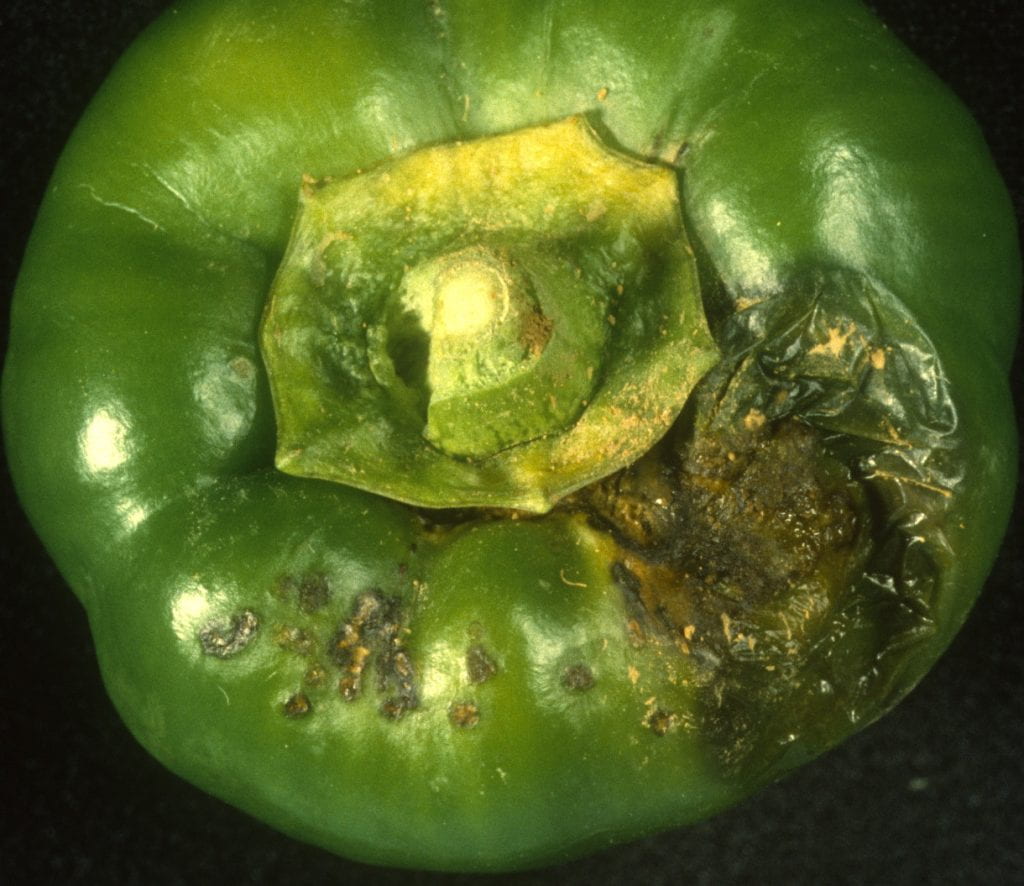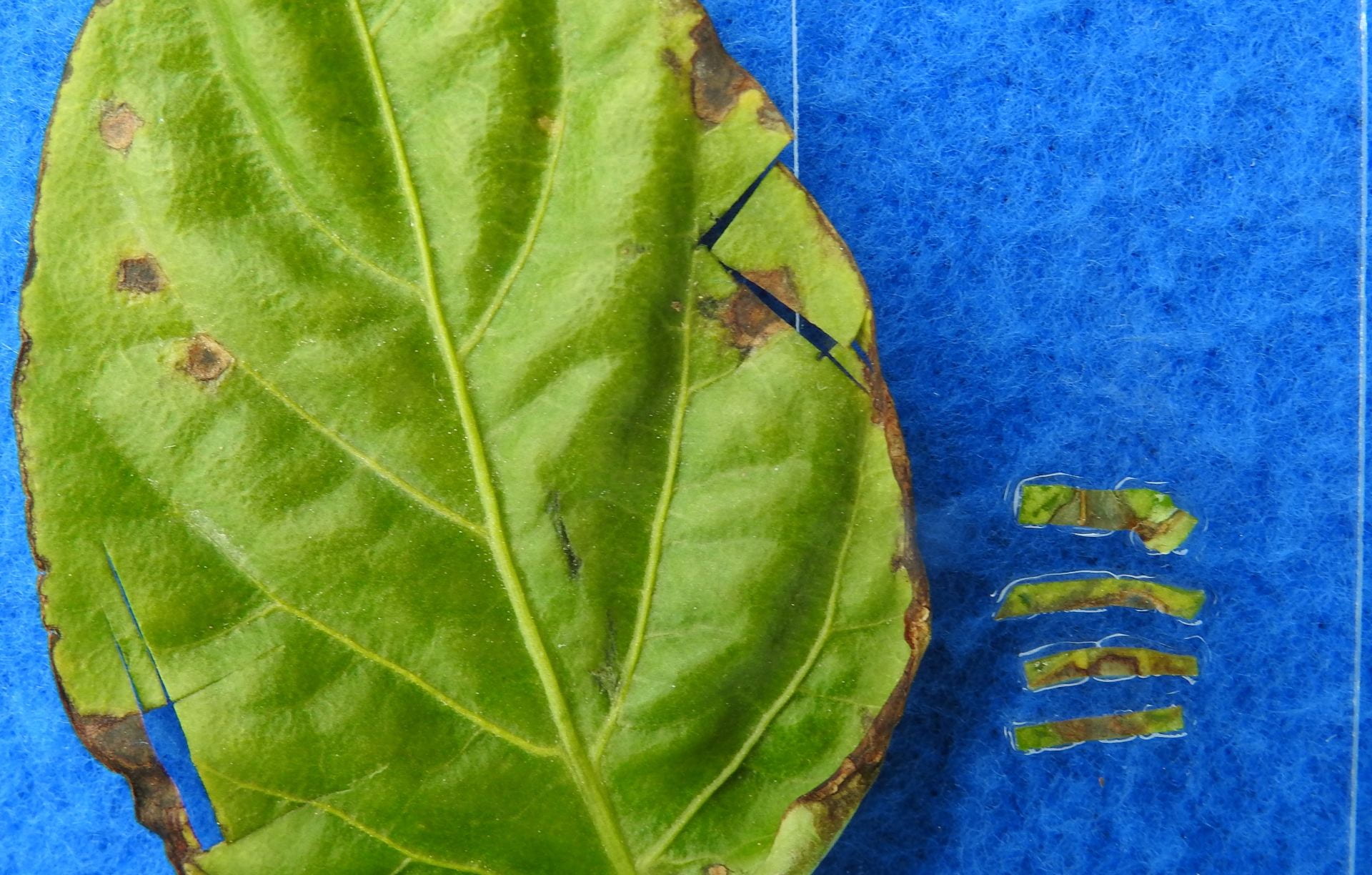Symptoms: brown spots develop on leaves, stems and fruit.
Spots on fruit can enable bacteria that cause soft rot to enter fruit, as occurred in the lower right area next to the stem of the fruit below. This can eventually result in the fruit completely rotting and dropping.
Diagnosis can be confirmed by looking for bacterial streaming in leaf pieces mounted in water. Copious amounts of streaming were observed from the two leaf pieces taken from the leaf in the following photograph plus two pieces from another leaf, and also from the four leaf pieces taken from the three leaves in the next photograph. Images of bacterial streaming are posted at the Stewart’s wilt page.
Symptoms can develop on seedlings in a greenhouse.
Sources of the pathogen include debris from previous affected crop and contaminated seed. Bacteria might be moved between nearby farms during a windy rainstorm. Tomato is also susceptible, but bacterial spot has not been confirmed on this host on Long Island. This reflects the fact there is host specificity among the multiple species and races of bacteria that cause bacterial spot. Four species in the bacterial genus Xanthomonas (X. euvesicatoria, X. vesicatoria, X. perforans and X. gardneri) have been identified as causing bacterial spot in pepper, tomato, and other solanaceous plants.
Management practices for bacterial spot include selecting resistant varieties when possible. Most resistance genes (e.g. Bs1, Bs2, Bs3, Bs4, and Bs7) are dominant genes that enable the plant to detect specific races of the pathogen and thwart infection. With race specific resistance the variety needs to have resistance to the race(s) present to be effective. The bacterial spot pathogen has proven adept at evolving new races not detected by the resistant variety, necessitating finding another resistance gene. Eleven races of the bacterial spot pathogens had been identified on pepper as of 2012. Two recessive resistance genes (bs5 and bs6) were identified recently. These genes work differently from the other resistance genes. When used together they provide resistance to all currently known races. X10R pepper varieties have a compliment of bacterial spot resistance genes that provide at least intermediate levels of resistance to all currently known races.
Select seed that has been tested and treated for the pathogen.
Treating seed with hot water can be effective for bacteria on and also inside seed when the seed lot is not heavily contaminated. It is best to have seed treated commercially when possible.
Fungicides are most effective applied preventively, similar to other bacterial diseases. Copper plus mancozeb is the standard recommendation, but is not inherently highly effective and resistance to copper, a major concern with bacteria, has been found to be common in pathogen populations examined (not done on Long Island). There are two plant activators: Actigard (only non-bell type pepper) and LifeGard (all pepper types). They need to be applied before disease onset for maximum benefit. Several organic fungicides are labeled that could be better options than copper for managing copper-resistant pathogen strains. They include BacStop, Thyme Guard, and Timorex Gold (botanical oils); Double Nickel and Serifel (Bacillus sp.); Procidic (citric acid); and OxiDate (hydrogen dioxide). These act on the pathogen and thus could be a good complement in a program with a plant activator. Some phosphorous acid fungicides (e.g. K-Phite) are labeled for bacterial diseases including spot. They act both on the plant and pathogen.
Do not apply fungicides when foliage is wet or use an air blast sprayer. Bacteria can be in this water. The force with which the pesticide solution is moved by the sprayer into the canopy can dislodge and move water droplets with bacteria. Force is greater with air blast than standard boom sprayers, and additionally can be of sufficient force to cause small wounds, especially if there are dirt particles, that enable bacteria to enter the plant. Horizontal movement of pesticide solution from air blast sprayers means bacteria can be moved further than with boom sprayers.
Do not work in crops with bacterial diseases when foliage is wet because bacteria can be moved by hands and equipment that touch water that has bacteria.
See APSnet article for more information.
Please Note: Fungicides mentioned are for use in commercial production, not gardens. The specific directions on pesticide labels must be adhered to — they supersede these recommendations if there is a conflict. Any reference to commercial products, trade or brand names, is for information only; no endorsement is intended. For up-to-date information on labeled conventional fungicides see Cornell Integrated Crop and Pest Management Guidelines for Commercial Vegetable Production and biopesticides see the Biopesticides website.













